Croatia is much more than sandy beaches and Slivovitz. The beautiful Balkan gem is home to an array of rivers which will make any dry fly fisherman’s knees go soft. And since travelling to- and staying in Croatia is still extremely cheap, lots of great dry fly fishing can be had on a very reasonable budget.
THE GACKA RIVER meanders calmly through the Otocac valley’s summery and lush-green cultural landscape, and even at first glance, we spotted a couple of well-nourished rainbow trout in the surreally clear water. This evening, while Klaus and I were rigging up our light fly rods with eager hands, a sense of rural post-romanticism intermingles effortlessly with Nature’s inherent bitter sweetness, and the immaculately combed Gacka meadows are ripe with Balkan essence. The famous chalk stream gushes up from the underground only a few kilometres upstream, but already here – below the old Gacka Hotel, which was destroyed during the war – the water flow is massive.
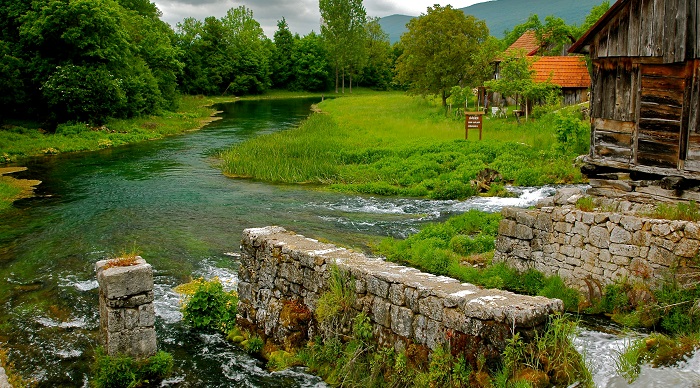
The river has carved itself deep into the terrain, and even though its crystal clear water masses poses a treacherous and distorting quality, it is fairly easy to tell that, here and there, the water depth exceeds four metres. It is deep, slow flowing, and extremely rich in subaqueous fauna – and the fish here grow almost five times faster than in other comparable rivers. It is no wonder that we are excited when we did the first couple of intuitive casts. Two days of fishing awaits us here, and we both sense that a lot of great experiences lie ahead.
THE EXPOSED MEADOWS downstream the old Gacka Hotel provides the framework for the fishing, and we quickly come to realize that the river’s sedate rhythm and lazy water masses demands innovative thinking in terms of fishing techniques and strategy. The hatches are minimal, and the fish are huddled along the bottom making long, thin leaders and weighted flies a necessity. The fish are sly and clever too, and since the water is both clear and slow-flowing, they have ample time to inspect (and reject) the flies. Consequently, they have to be not only ultra-realistic and minute; they have to be dead-drifted with great care and precision. To put it differently, the fishing isn’t easy – but we rose to the challenge, and it turns out that it doesn’t take too long before the first strikingly good-looking and well-nourished rainbow trout thrash about at the end of our lines.
THE FISHING with the heavy nymphs, the strike indicators, and the extra weight on the long leaders is exciting and challenging, but at noon, when the first sparse hatches appear, our mindsets subtly transform and we are now tentatively casting small imitational dry flies. We are told that it is quite common for the hatches to be extremely confined to the period between 12 and two o’clock, and since we are both dry fly fishermen incarnate, we are intensely focused on the increasing surface activity for the next couple of hours.
“The fish are sly and clever too, and since the water is both clear and slow-flowing, they have ample time to inspect (and reject) the flies.”
The rainbow trout are rising, but they definitely aren’t easy to fool. The hatches are complex and rich and the fish display a rather frustrating preferential moodiness. One minute they’ll be eating tiny spent spinners. The next, they’ll munch on surface film emergers, and we constantly have to be sharp, observant and experimenting to succeed. Our patience and tenacity pays off, however. During the couple of hours that the hatches last, we manage to lure a small handful of beautifully coloured and hard-fighting rainbow trout – and our dry fly-hearts swell up in response and beat stronger than ever.
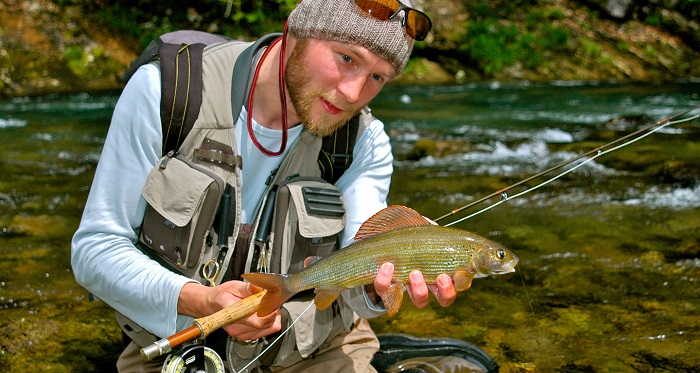
THE FISHING ON THE SECOND DAY takes place just below the Gacka source and the charming old water mill, which is situated here. The whole area bubbles and trickles with water, and lots of minute brooks rush in and accompany the Gacka River in a wilful and lush wanderlust downstream. Klaus starts out fishing in the pool just below the water mill where the water flow is still rather minimal. He hooks up with a good fish in his first cast, and in no time whatsoever, he has landed a handful of frantically fighting rainbow trout, that hit his dry fly without hesitation. It seems the fish are a bit headier today, and our spirits are high as we slowly move downstream in search of new scaly playmates.
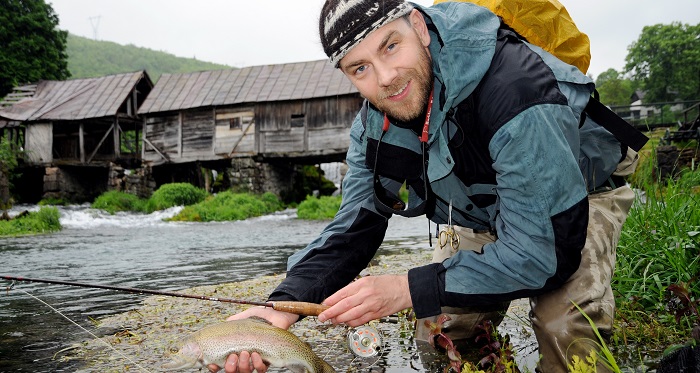
IN NO TIME WHATSOEVER, the river assumes its rightful expression, and even though we have only journeyed a couple of hundred meters downstream from the source, the river is both deep and wide. We each find a suitable tempo and rhythm, and we both experienced some fine fly fishing for brown- and rainbow trout, which to a growing extent involves small, weighted nymphs and long, slim leaders. Undoubtedly, Klaus catches the day’s most impressive fish – a mercilessly beautiful brown trout a little shy of 50cm. It is revealed by it fiery golden flanks in the main current some 200 metres below the water mill. And with great care and precision, Klaus manages a long cast which drops the tiny nymph in a place where it is carried right past the fish. The gullible brown trout picks up the fly, Klaus lifts the fly rod, and in that same instant a hectic battle begins. The brown trout desperately attempts to find shelter in the lush weed beds, but every single time, Klaus turns and steers the fish out into the open. In the end, he guides a drop-dead gorgeous, golden and red-dotted creature into the net, and I shoot a series of concluding pictures with the old water mill as a meaningful backdrop. The release of the trout poignantly marks our departure from the river.
FROM THE OTOCAC and Gacka valleys, we journey onwards to the immensely charming medieval city of Ogulin and the cosy Frankopan Hotel where we will be staying for the night. On the way, we visited the unique Plitvice Lakes National Park, which is comprised by a seeming infinity of majestic waterfalls, eerily clear lakes, rugged mountain plateaus and curious microcosms. In the Ogulin area, diverse rivers such as the Dobra, Vitunjcica and Kupa are found. The Dobra harbour’s fine populations of brown trout, rainbow trout and last but not the least, Danube salmon; and with its rocky bottom; giddily flowing water and great width it is a river in the true meaning of the word. The Dobra-tributary, Vitunjcica, is a beautifully meandering but small river, and it is known for its sublime fishing after rainbow trout, which grow to dramatic sizes. Kupa on the other hand is a real mountain river, and it is renowned for its marvellous grayling fishing.
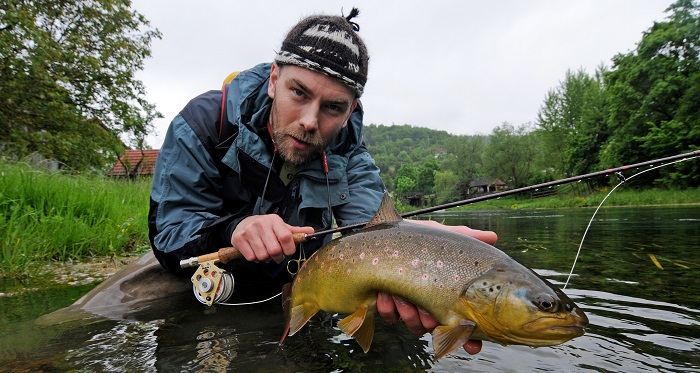
BOTH DOBRA AND VITUNJCICA suffer from snowmelt further up in the mountains and not least massive downpours – but this doesn’t prevent us from experiencing some fine and captivating dry fly fishing. Especially Vitunjcica, which cuts through dense forest in the upper reaches, offers some hectic dry fly fishing in the midday hours. We fish here most of our third day, and we experience one hot tempered rainbow trout after the other rising confidently to our sedge and mayfly imitations, breach the surface and disappear towards the bottom with them anchored in their jaws. Our dry fly techniques are steadily adjusted and refined, and even though we didn’t catch any big fish, we see them here and there – and we also make contact. When the day finally draws to an end, and we conclude the fishing, we are completely full of heart-warming impressions and our dry fly-hearts beat with renewed purpose and will. We have caught more rainbow trout, than any of us can count, and knowing that tomorrow will take us to the surreally beautiful Kupa River, we lay ourselves to sleep with impatient minds.
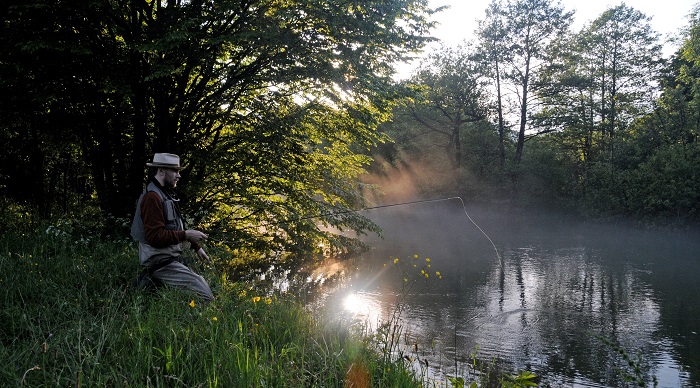
THE FOURTH DAY ARRIVES, and we immediately head northwest towards the Kupa River – a journey which requires a fairly arduous drive through rugged but beautiful mountain terrain. The river marks the border to neighbouring Slovenia, and it is the final stop on our fantastic journey through Croatia. It is every dry fly fisherman’s dream, and the many powerful and beautifully marked grayling scattered about in the river’s riveting water masses offer intense challenges. Like the Gacka, the Kupa River simply gushes from the chalky Croatian underground born by accumulating subsurface water reserves. It originates in the gorgeous and rugged Risnjak National Park, and it is cool, clear and more or less temperature-stable throughout the year. We are here with Zlatimir Kostelic, the captain of the Croatian fly fishing team; a guy, who – despite having seen more trout- and grayling waters than most – spends the majority of his fishing season on the Kupa River. Oh, and he doesn’t even live close by.
KLAUS fishes with our immensely acclimatised host on some of the upper river stretches, and I later come to realise, that he has been out fished in the most demoralising way – Czech Nymph style! Being both observant and adaptable, he has acquired lots of exciting nymph technical experience too, but when we met later on, we both agreed that it was time to find a river stretch where we can do some strike-indicator fishing – or better yet, some dry fly fishing. We have both caught a handful of good, well-nourished and immensely beautiful grayling — fish that have delivered hectic fights in the eerily clear water masses, but we are hungry for more.
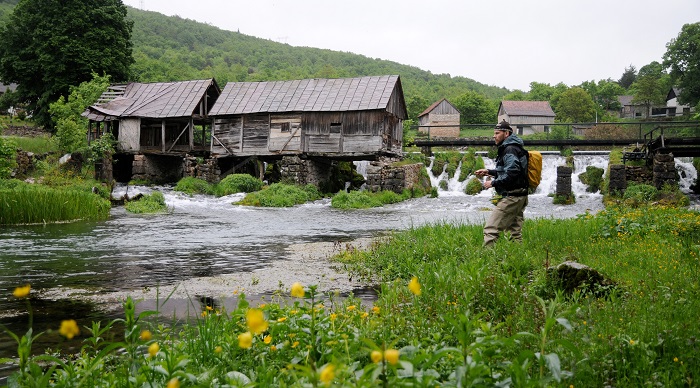
A DECENT WALK downstream through rugged deciduous woods leads us to a stretch of the river that tears and rips at our overwhelmed fishing hearts. This stretch seems absolutely pristine, and one freshly riveting run supersedes the other orchestrated by towering mountains, that mirror their lush-green slopes self-complacently in the river’s twinkling water. We quietly work our way downstream, hook several fine grayling, and finally – in the most intense heat of noon – we spot some rising fish, that cut wilfully through the water masses to ensure some insect nourishment on the surface. For the next couple of hours, we catch some extraordinarily handsome grayling between 35 and 45cm on carefully presented #18-22 dry flies. It is challenging and intense, and we completely lose ourselves to a subtle rhythm unique to this mountainous region – a rhythm that clears our minds of any burdening sense of time. It is nothing short of breathtakingly beautiful, and we both agree that this is some of the best dry fly fishing imaginable – even if the hatches and thus the dry fly fishing only last for a couple of hours. In fact it would have been borderline vulgar if the eminent dry fly fishing had lasted all day.
“…we both agree that this is some of the best dry fly fishing imaginable – even if the hatches and thus the dry fly fishing only last for a couple of hours.”
THE EVENING FISHING is incredible. Not so much because we catch lots of fish – which we actually do. But mostly because the river and the surrounding mountains, with the dimming lights, adorn a wondrous and captivating glow, that makes the emerald blue and lush green of the river and the mountains blush with renewed vigour and life – as if the coming darkness was going to last forever. We catch a small supplementary handful of grayling, and find the fish rising to microscopic midges on one of the rare slow-flowing and deep stretches of the river. Only the most minute dry flies in our fly boxes, such as hopeless #28-32 gnats, will do the trick – and only with the greatest of difficulty. In return, even the biggest graylings in the river are now on their fins, and we therefore cannot help but fully and eagerly accept the challenge, and all the many defeats and few but overwhelming successes that are to follow.
Suddenly complete darkness descends, and the sublime fishing ebbs out – just like a beautiful melody that quietly fades away. The river is still there – slumbering away in the dead of night, but even though it whispers temptingly to us from afar as we head downstream towards the car, we have irrevocably placed our final dry fly casts on the river’s fleeting surface film. We have been solemnly quiet most of the day – like a couple of devout believers in Church, but now the silence has been broken by joyful conversation. And in particular the talk revolves around when we’ll be able to go back to Croatia, and not least the heartbreaker Kupa.
Words By: Rasmus Ovesen
Photos By: Rasmus Ovesen and Klaus Boberg Pedersen

